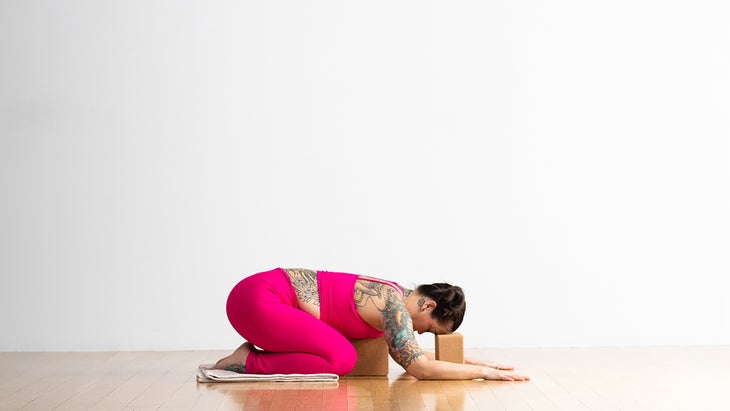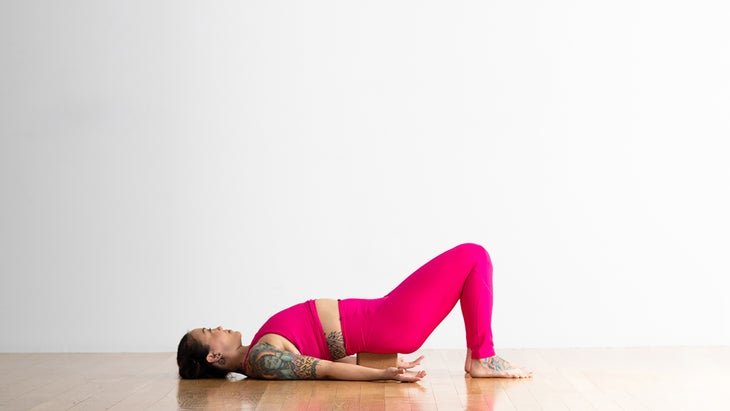“], “filter”: { “nextExceptions”: “img, blockquote, div”, “nextContainsExceptions”: “img, blockquote, a.btn, a.o-button”} }”>
I had recently completed 500 hours of yoga teacher training and was extremely proud of how strong my almost 50-year-old body had grown during my practice. I was regularly attending “advanced” vinyasa flow classes, and each time I arrived at the yoga studio in Santa Monica where I practiced, I was surprised, relieved, and proud of myself for finally being able to release most of my insecurities about what my body could and could not do.
It seemed to me that nearly everyone else in those classes had endless energy and could almost levitate during their vinyasa sequences. Meanwhile, I was busy focusing on what I could do to keep up without passing out. I was doing my best to listen to how I was feeling that day so I could respect the connection of mind, body, and breath.
I navigated each day as best as I could as a new yoga teacher, a mom of two girls, a wife, a stepmom to two boys, and a fur mom to two crazy dogs, turning to the lessons I had absorbed during my training and trying to stay focused on the lessons from Sanskrit, yoga philosophy, and my frequent asana practice to bring some peace and harmony into my life. I thought I had this yoga thing down!
Yet I was left with an unsettling sense of needing something else. This disconcerting feeling stayed with me all the time—even keeping me up at night. I wasn’t sure what that something could be. I understood that whatever I was ruminating on would be revealed in time. I just had to trust and wait for the answer.
One day while I was taking class, a gap in the rows of students standing on their mats caught my eye. I glanced over and saw that a regular student—someone who I’d noticed was incredibly strong—was in Balasana (Child’s Pose).
It was all I could do to focus on what the teacher was saying. I knew that we were supposed to think of coming to yoga as our time and no one else’s, but I was completely distracted. Thoughts were swirling around in my head. Why wasn’t the teacher making sure she was okay? Was she going to get up? Why would she come to this level of a class only to rest in Child’s Pose the entire time?
I tried to focus and return to what was happening on my mat, but it was useless. Then I noticed our teacher, who had been weaving her way between our sweaty bodies and motivating us, calmly bend down and place her palm on the woman’s back. Then she stood back up and continued teaching as though nothing was amiss.
No one else seemed to be paying this woman any attention. She stayed in Child’s Pose for the entire 90 minutes. She simply stayed put while I was ready to jump out of my skin. The rest of the class was a blur, and even when I was in Savasana, I felt restless and confused, but it was no longer about anyone else. I was fixated on why this made me feel so uncomfortable. What was I missing that everyone else seemed to intuitively understand?
It wasn’t until I was on the drive home that I had a realization. Because of my upbringing, because of the way I packed each day with numerous activities and responsibilities, I never gave myself permission to pause and rest. I spent every minute of my days (and most nights) doing and achieving, only to stop when I could no longer keep my eyes open. I was constantly productive. So I regarded taking a 90-minute Child’s Pose in a crowded yoga class as an unnecessary luxury.
Just becoming aware of that relentless insistence on productivity caused me to experience a profound release from somewhere deep within my tired body. That night, I left the extra chores undone. Instead, I took a long soak in the bath. And I slept better than I had in years.
I had finally given myself permission to truly and deeply rest.
How to find rest
Over the following days, every time I opened a book or flipped through a magazine, information about different restorative modalities caught my attention. It wasn’t long before I discovered an upcoming training that integrated several modalities, including gentle movement, restorative poses, breathwork, and meditation as well as Reiki.
This was a revelation for me to manage my own stress and I began to see that by combining these methods, I was able to relax on an even deeper level than ever before. As I integrated these practices into my life, I started to create routines that made a big impact on my daily life. For example, I noticed that by placing one hand over my heart and the other on my belly while diffusing lavender oil before bed, I was able to sleep better. During a busy day, I would pause and take two minutes to notice my feet on the ground while I practiced equal breathing.
As my stress levels decreased, I became more aware of what my body was trying to tell me. It was always difficult for me to just breathe or take a moment to pause, but each time I added another mindfulness tool to my repertoire, I was able to relax deeper than the day before.
Taking rest to the mat
Today, I include time for rest in each of my classes, no matter what type of yoga I’m teaching. I’ve found that even the strongest, most advanced students appreciate it. I might instruct the class to come down to the mat for supported Setu Bandha Sarvangasana (Bridge Pose) with a bolster or a block under the low back toward the end of class. And instead of having my students drop to the mat after a vigorous flow for a quick five-minute Savasana, I now allow for at least 15 minutes of rest for them to unwind.
I also allow for rest in the middle of a hatha or vinyasa class. For example, after a few rounds of Sun Salutations, we will stand in Tadasana (Mountain Pose), close our eyes, and focus on all the sensations in our bodies and our breath. Elsewhere in class, I might suggest a supported Virasana (Hero’s Pose), resting on a block instead of the heels. I encourage students to take slow and easy breaths, close their eyes, and tune into their senses.
After class, students often ask me how I knew exactly what they needed. Truth be told, I don’t. I try to tap into the energy that is present at the beginning of each class, but I also take note of how I’m feeling that day. I have found that we are all more similar than we think, so if I’m feeling the weight of the world, chances are my students are, too.
When I look back on that woman’s decision to let herself rest in Child’s Pose for almost 90 minutes years ago, I realize that now I find it not only normal, but necessary. After you’ve allowed yourself the pause, you can no longer ignore the need. It’s human nature to have routines and we can easily create habits, especially when it’s something enjoyable. When we can truly experience the effects of giving ourselves permission to rest on a regular basis, our mind and body connection wants more. We are breathing deeply, oxygenating our systems, and slowing our heart rates. We return ourselves to a state of calm and equanimity, which is what we need to withstand the stress of everyday life. Even if you can only carve out five minutes a day, take that time to stop what you are doing, notice your breath, and allow silence to surround you.
Poses to help you rest and release
Supported Setu Bandha Sarvangasana (Supported Bridge Pose)
Lie down on your back with your knees bent and the bottoms of your feet on the ground, hip distance apart. Keep your head flat on the mat rather than elevated with a pillow or folded blanket. Press your feet into the ground and lift your hips just enough to slide either a block, bolster, or folded blanket under your low back and hips. Remain here for 3-5 minutes, then lift your hips again to remove the support underneath and lower hips back down to the ground slowly. Rest your hands on your belly and absorb the effects of the pose for several rounds of breath. (If you like, you can create a medium-size loop in a yoga strap and encircle your thighs with the strap to help you relax your legs.)
Note: If you have glaucoma, neck issues, or are in your third trimester of pregnancy, skip this pose

Supported Salamba Balasana (Supported Child’s Pose)
You can take support in Child’s Pose in any of several different ways. First, come to kneeling on the mat and separate your knees as you bring your big toes to touch. You can bring a blanket beneath your knees if you like. Take a bolster lengthwise in front of your body and use it as a support for your chest as you turn your head to one side. Or you can take a block lengthwise beneath your chest and another block crosswise beneath your forehead. You can place a rolled blanket on your calves to provide support for your seat. Or any other variation you like. Remain in this pose for 3-5 minutes, then use your hands to slowly come back to seated.
Note: If this pose strains your knees, try putting more blankets on your calves for extra support, or lie on your side in a fetal position.

Viparita Karani (Legs Up the Wall)
Place your yoga mat so the short side is touching a wall. Double fold a blanket as a pillow for your head. If you’d like extra cushioning for your low back, double fold a second blanket and place it next to the wall. Sit on your mat sideways at the wall with your knees bent, feet on the ground, touching the wall with one side of your body. Begin to lie down on the mat or blanket, while you swing your legs up the wall. Take your time and move slowly. Once your legs are up the wall, check to make sure your hips and glutes are resting on the mat or blanket. If they are elevated, you might be too close to the wall, so scoot back until your hips and glutes are comfortably resting on the mat.
If you’d like to use a strap to help your legs relax, place a loop in the strap about hip-distance apart and shimmy the strap past your knees, making sure the strap buckle is not resting on your skin. Send legs back up the wall and adjust the blanket under your head. You can rest your arms by your sides or rest your palms on your belly. Allow your legs to release. Remain in this pose for 3-5 minutes.
To come out of the pose, bend knees towards you, remove the strap and roll over to your side and rest there for a minute before slowly pressing up to a seated pose.

